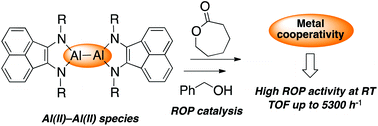Low valent Al(ii)–Al(ii) catalysts as highly active ε-caprolactone polymerization catalysts: indication of metal cooperativity through DFT studies†
Abstract
The present study first describes the reactivity of low valent Al(II) and Ga(II) complexes of the type (dpp-bian)M–M(dpp-bian) (1, M = Al; 2, Ga; dpp-bian2− = 1,2-bis-(2,6-iPr2-C6H3)-acenaphthenequinonediamido) with cyclic esters/carbonates such as ε-caprolactone (CL) and trimethylene carbonate (TMC). CL and TMC both readily coordinate to the Al(II) species 1 to form the corresponding bis-adducts (dpp-bian)Al(L)–(L)Al(dpp-bian) (3, L = CL; 4, L = TMC), which were structurally characterized confirming that the Al(II)–Al(II) dimetallic backbone retains its integrity in the presence of such cyclic polar substrates. In contrast, the less Lewis acidic Ga(II) analogue 2 shows no reaction in the presence of stoichiometric amounts of CL and TMC at room temperature. In combination with BnOH, the dinuclear Al(II) species 1 revealed to be an extremely active Al(II) initiator for the controlled ROP of CL at room temperature, outperforming all its Al(III) congeners reported thus far. Detailed DFT studies on the ROP mechanism are consistent with a process occurring thanks to the metallic cooperativity between the two Al(II) proximal (since directly bonded) metal centers in 1, which undoubtedly favors the ROP process through bimetallic activation and thus rationalizes the unusually high CL ROP activity at room temperature.



 Please wait while we load your content...
Please wait while we load your content...